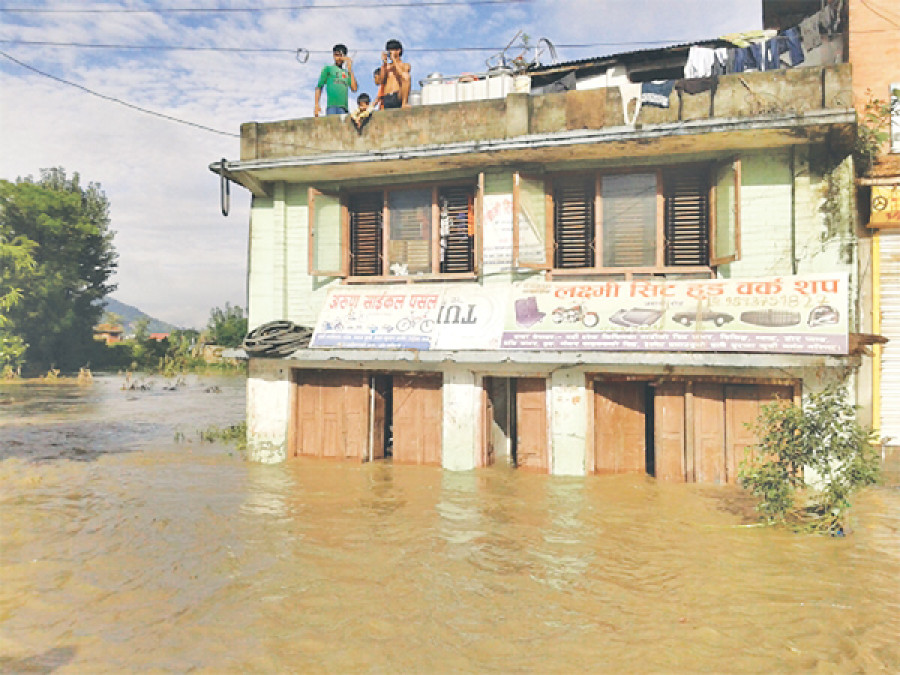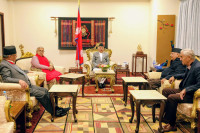Opinion
History of disasters
Authorities in the Capital conveniently forget the past and allow people to live in disaster-prone areas
Gyanendra Gurung
When George Santayana wrote, “Those who cannot remember the past, are condemned to repeat it” in his book, ‘The Life of Reasons’, he perhaps did not have natural hazards in his mind. But if we want to be prepared for an reoccurring geo-environmental hazard, the simplest solution would be to study historical records on disasters and learn ‘something’ from the past. One can actually do away with consulting bulky reports in Nepal, which are at best left in the dark corners of the libraries of I/NGOs and government offices to collect dust and never put into action.
Take for example the recent floodings in the Capital; they were not only the consequences of poor judgement of the local authorities, but also the complex hydrogeological environment. While the unwary victims might not have been aware of the historical floods that took place in their locality, we cannot let the local authorities off the leash for their amnesiac disposition which permitted permanent settlements in vulnerable areas in the first place. Clearly, studies have been conducted, unsafe areas designated, and mitigative measures adopted. And yet, we tend to forget the past and allow people to live and rebuild on risky grounds.
Forgetting the past
Back in 2011, when an earthquake struck off the coast of Japan, a destructive tsunami wiped out many costals towns. However, a tiny coastal town of Aneyoshi was safe because they had heeded to the warnings their ancestors had engraved on centuries-old stone tablets—the markings of the highest point of seawater levels during ancient tsunamis in that area. These ancient tablets, which are found all along the Japanese coast, are testimonies of past disasters, and provide injunctions as to not build anything beyond and below that point, in order to remain safe. But other coastal towns of Japan, trusted their advanced Early Warning System, which ignored these historical omens and tragically, the mighty tsunami breached the modern protective sea walls, damaging the Fukushima Dai-ichi power complex that resulted in a major nuclear disaster.
As for us in Kathmandu, we have a much shorter memory span than the residents of Aneyoshi or that of our very own ancestors. We are well aware that every year, the monsoon drags along a cascade of disasters in small and large packages in different parts of the country. And, for the settlements built on the low-lying flat lands in the vicinity of major tributaries or floodplains of the Capital, there are plenty of historical notes, stories, and anecdotal evidences of floodings in those areas in the past backed by scientific clues. Should not such compelling information be incorporated in all aspects of engineering works built in and around rivers? If it had been, it would have otherwise guided engineers to advocate for flood-proofing of critical and important facilities in such communities.
However, we should also note that the increasing intensity of flash floods in the city are not merely the cumulative effect of haphazard urbanisation and enroachment of critically-threatened floodplains. In fact, much of misery resulted from poor engineering practices, which unfortunately aggravated the risk of flooding in an otherwise normal monsoon cycle. Just compare the numerous poorly-engineered ‘modern’ bridges and temporary crossings that have sprouted up in the city with the properly-engineered bridges that our ancestors built across the Bagmati river of Kathmandu. Clearly, our ancestors were much more mindful of the history of our natural environs, than modern-day engineers, who, I believe,are over-optimising their engineering plans below a dangerous threshold and jeopardising the state of both human lives and our natural ecosystems.
Institutional foresight
Natural disasters are not going to disappear overnight, even as our society straddles towards a more advanced and sophisticated era. Instead it is becoming increasingly clear that the number of calamities will only surge in the coming years; the natural forces will get stronger due to our efforts to accommodate a growing population in poorly-planned urban sprawls throughout the nation. So, we need to make the public aware of the geo-environmental history of our surrounding. They have to know what kind of strong and capricious forces they are living with. This reminds me of my community along the banks of Samakhusi Khola in Kathmandu. I grew up witnessing the unprecedented strength of this small tributary when it used to flood large swaths of land during the monsoon. Now that it’s natural pathway has been tethered and made invisible underneath the dense concrete jungle, new residents are oblivious to the fact that they are harbouring a sleeping monster with a might unbeknownst to them.
Thus, we cannot always blame the victims for lacking disaster preparedness. It is the responsibility of our ‘institutional actors’—politicians, policy makers, and local authorities—to remember the history of natural disasters and to ensure that precautions are taken for the safety of their constituents. They have to educate people about the impacts of natural hazards that they might face, prepare them by laying out best options for mitigating such risks, and develop strategies whereby the resilience of community towards future disasters can be enhanced. They cannot merely respond whenever a disaster strikes; they have to support investment in proper measures that can curb and mitigate such disasters beforehand.
Tweaking the plan
Against this backdrop, it is further worth pondering upon why we still fail to tackle such disasters despite the fact that our government, with the help of I/NGOs, has aggressively pushed forward the agenda of disaster risk reduction ever since Nepal adopted the Hyogo Framework for Action 10 years ago. The main objective of this framework—which have been upgraded to the Sendai Framework in March 2015—is to have nations pledge towards building the resilience of communities to face disasters that threaten development. But, all that we have so far are reports-after-reports of meticulously well-written and scientifically-prescient action plans that are filled with development aid jargons, with barely any visible successes. Could the problem lie in the fact that these plans are only based on the long-term threats of climate change scenarios—that span over 100 or more years? As the dangers of climate change are real, we need to re-formulate these actions plans for disasters that play out over a much shorter time span. So, the next time when we are writing another elaborate ‘adaptation plan’ for disaster risk reduction, maybe we should prioritise the solutions that can help us mitigate immediate and reoccurring disasters that occur every year or in a decade over to the ones that can happen in an unforeseeable future. And, let us hope that the memories of this year’s disasters are not lost in the years to come.
Gurung is a Post-doctoral Research Fellow at Chonbuk National University, South Korea




 10.12°C Kathmandu
10.12°C Kathmandu











